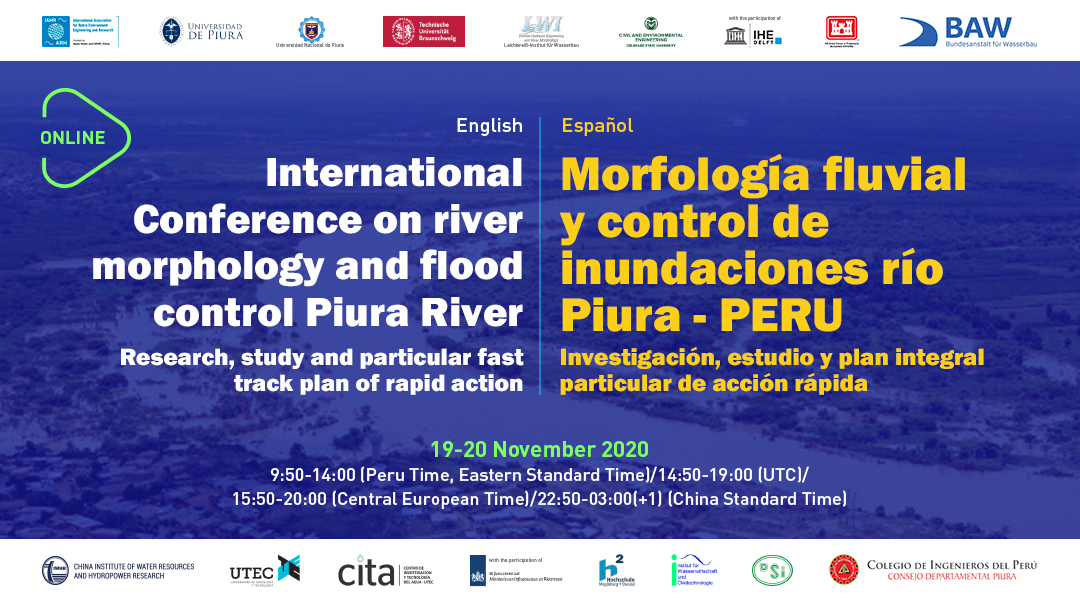International conference River morphology and flood control Piura River
« Back to list of video collections
Research, study and particular fast track plan of rapid action "design as you go".
150 years of human intervention have transformed the Piura River, Peru‘s main irrigation area, into a semi-channelled and regulated river with levee embankments, groynes and sedimented floodplains in the lower river basin, Bajo Piura, and a non-river-channelled reach of a sediment ejection source area in the upper basin: Alto Piura. The deviation of the natural course of the Piura river in the lower river basin, which in the past discharged into the sea, a proper river mouth, to a new point of discharge, a non-proper river mouth, with a longer river length in the last century, has resulted in a complex problem in the river morphology of the lower river basin. As a consequence, an aggradation (sedimentation) process is occurring in the lower river basin. Simultaneously, the degradation of the upper river basin, which is the source of sediment ejection into the lower basin, has continued unchecked, leading to the necessity that mitigation measures be implemented to counteract the streambed and river bank level changes, if adequate measures are not taken to solve the problem. An effective evaluation of the riverbed in this degradation-aggradation process in the upper, intermediate and lower river basins requires an understanding of the morphological processes involved in river channel geometry adjustment and projected equilibrium conditions.
The objective of this research, which will be the main topic of this conference, was to study how the aggradation-degradation process of the Piura River streambed and banks might be managed by means of an adequate river training and flood control system:
decreasing sediment transport capacity, by rectifying/realigning/channelling the river in the upper river basin, also referred to as "river training", through flood protection in critical reaches, or by stabilizing the river bed and banks.
increasing sediment transport capacity in the lower river basin by river-narrowing in the non-river channelling reach and creating an adequate outflow, and also by providing flood protection in the lower basin, through a process of controlled general erosion. This will make it possible to restore hydraulic capacity in the existing channelled or river training reach.
The objective of this conference is to alert local authorities to the urgency of addressing the issue of flood control in Piura, through adequate "engineering principles, organization, administration and ethics" and non-political and non-corrupt implementation, four years after the destructive El Niño 2017 flood event, caused by the lack of an integral plan and adequate decision making.
The main focus of the conference will be the following key themes:
A "particular" comprehensive study understanding the importance of river morphology, sediment transport and hydraulics for the control of floods in the Piura River.
It answers the question why was Piura flooded?
The phenomenon of degradation (erosion) and aggradation (sedimentation) of the Piura River in its upper and lower basin.
Morphological changes in the river.
A fast-track action plan and conceptual strategies for river training and flood control, alternatives and recommendations.
Anatomy of the Piura River: a history of interventions: administration, policy, and regionalization.
The conference will also include presentations on fluvial morphology, flood control and how highly qualified river engineering authorities can manage rivers efficiently without political influence while maintaining engineering and ethical principles. Invited sessions from river engineering and flood control experts will be presented within the framework of river morphology and flood control of the Piura River.
The conference introduces to a fast track action plan, design as you go, with strategies for flood control, alternatives and recommendations.
An adequate flood control system based on several variables, besides of social and environmental issues will take in fact several years, and in the meantime a flood defence in the lower basin is also a must, up to the effective flood control system is ready.
-
[Day1] Pablo Spalletti - Opening of International Conference on River Morphology and Flood Control Piura River
2022-06-23 -
[Day1] Antonio Abruna - Opening of International Conference on River Morphology and Flood Control Piura River
2022-06-23 -
[Day1] Antonio Mabres - 4 Years after Flooding
2022-06-23 -
[Day1] Slobodan Simonovic - From Flood Risk Management to Building Resilience to Flooding: Implications for Decision Making
2022-06-23 -
[Day1] Till Branß - Levee Formation in Compound Channels with Floodplain Vegetation
2022-06-23 -
[Day1] Cesar Alvarado Ancieta - Particular Comprehensive Study for the Control of Floods in Piura River
2022-06-23 -
[Day1] Panel Discussion of International Conference on River Morphology and Flood Control Piura River
2022-06-23 -
[Day1] Pablo Spalletti - Closing of International Conference on River Morphology and Flood Control Piura River
2022-06-23 -
[Day2] Jorge Reyes - Opening and Day1 Summary of International Conference on River Morphology and Flood Control Piura River
2022-06-23 -
[Day2] Benoit Camenen - Interest of 1D Modelling for Assessing Bed Evolution of a Long River: Application to the Middle Loire River, France
2022-06-23 -
[Day2] Edwin Omar Vences - Why There Is Not a Integral Plan After 4 Years?
2022-06-23 -
[Day2] Nils P. Huber - Dealing With Waterway Challenges in Germany & Morphodynamics and Sediment Management: A Brief Glimpse Into Coping With the Legacy of Waterway Development in Germany
2022-06-23
